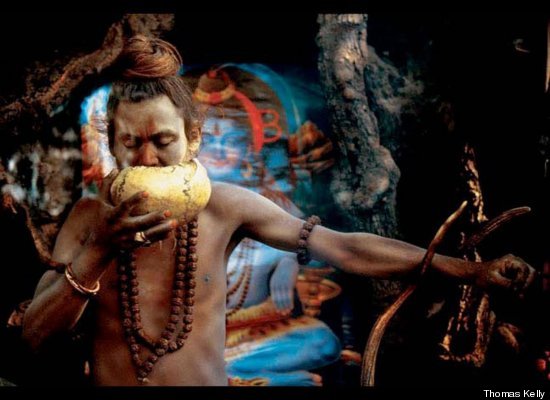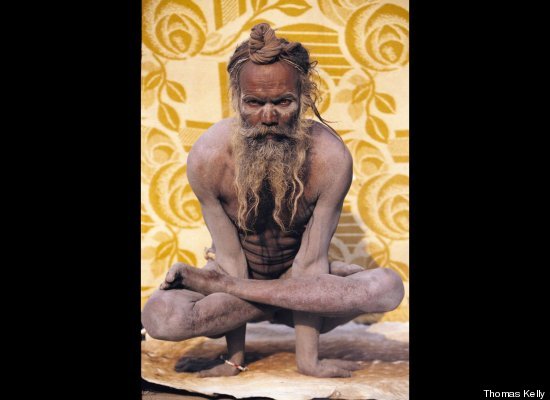At the Rubin Museum of Art til July 4... and online

I walked past the Rubin Museum a few times on my last trip to NYC. Each time, I stopped and stared at the deities outside. Why are they there? What's inside? Finally, I took some photos.
I showed the pics to Catesey, who told me I had to go to the museum, which specializes in the art of the Himalayas.
The Rubin Museum of Art has the largest Western collection of religious art from cultures of the Himalayan mountain range, including those of Nepal, Tibet, and Bhutan as well as the interrelated traditions of India, Mongolia, and China.
So the next day, between classes at Dharma's, after a live vegan feast at Bonobo's (which required a lot of chewing), Parvati and Kali went to the Ruben Museum.
It was amazing.
The most dramatic and arresting display was the first one saw: a golden Tibetan shrine room that was utterly exquisite. Like good little yoginis we immediately knelt down, paid our respects, and then sat on the floor in reverie. It was stupefyingly still and beautiful. We could have stayed there for eons.

A spectacular shrine room on loan from the Alice S. Kandell Collection allows visitors an extraordinary opportunity to experience Tibetan Buddhist art in context. Containing approximately 170 works of art created between the 13th and 19th centuries from the Tibetan Plateau, China, and Mongolia, the shrine room highlights the religious context in which these sacred objects would be found in a private Tibetan shrine.
All of the objects - thangkas as well as sculptures of buddhas, bodhisattvas, tantric deities, female deities, wrathful deities and teachers - are arranged on traditional Tibetan furniture and according to the hierarchy they assume in Tibetan Buddhist practices. Ritual objects, such as butter lamps, offering bowls, vajras and bells, rosaries, conch trumpets, horns and reeds, and hand drums, are also on view.
The Tibetan Shrine Room exhibit lasts through the end of the year; view more images here.
We also saw many antique Tibetan carpets and statues of various gods.
One murthi, of the Buddha, showed Him with his hair up, save for two curly strands of hair that ran down the sides of His neck. I wore my hair like that the following day, thinking I was on the cutting edge of asceticism (that is, until I saw a woman with the exact same hairdo on Million Dollar Decorators).
* * *

Somehow, we missed Thomas L. Kelly's photo exhibit, Body Language: The Yogis of India and Nepal.
Somehow, though, I caught it on the Huffington Post this morning.
And it too is amazing.
In fact I was late to Suddha's Mysore class this morning because I was so engrossed in the images and their captions.

Aghori, 2000
Pashupatinath, Kathmandu, Nepal
The Aghori sub-sect of Shaivas closely resembles one of the earliest organized groups of Hindu ascetics, the Kapalikas, or "bearers of skulls," who originated
in the ninth or 10th century. Like the modern-day Aghori, Kapalikas worshipped the terrifying manifestation of Shiva, Bhairava, and were known to perform human sacrifice, which often involved offering their own flesh to the deity in acts of self-mutilation and even ritual suicide. Though these extreme practices have evolved into symbolic acts today, the Aghori still use human skulls in rituals, as seen in this photograph. Drinking out of a skullcup (kapala) is a magical act in which the sadhu partakes of the deceased's life force, controlling it with the use of mantras. The skull also serves as a constant reminder of human mortality and the necessity of conquering the duality of life and death.
Because of their taboo behavior, Aghori ascetics remain on the furthest fringes of Hindu society. They drink alcohol, eat meat and use obscene language, transgressions that defy conventional Hindu rules of purity and pollution. Through ritual activities that deliberately combine behavior considered sacred and profane in the Hindu tradition, the Aghori seek to see all things as one, especially opposites.
Check out the photo exhibit here.
Make sure you read the captions, which contain a lot of valuable information about yoga. Kelly explains who the people are and how/whom they worship as well as the symbolism of their dress and tilak marks....
and notice how different they look from our

Kukkuta Asana, 2010
Pashupatinath, Kathmandu, Nepal
Aside from a life of simplicity and religious focus, many sadhus engage in a diverse array of practices, both internal and external, in order to attain higher states of awareness and consciousness. This sadhu has chosen Hatha yoga and shows off the results -- a well-disciplined, strong body -- by holding the kukkuta asana, or "cock pose." Although Hatha yoga is partially physical in nature, there are many internal, mental practices that accompany the outer, physical postures. Through the united control of body and mind, the sadhu prepares for deeper, more advanced meditation.
Hatha yoga also helps the ascetic with sexual discipline and sublimation. Through yogic techniques that manipulate and control the body's physical processes and energetic principles, a sadhu's semen may be retained and converted into shakti, the divine female power that is the basis of all creation.
No comments:
Post a Comment